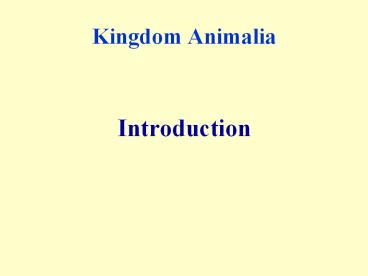Kingdom Animalia - PowerPoint PPT Presentation
Title:
Kingdom Animalia
Description:
Kingdom Animalia - Diversity Metazoa Parazoa Eumetazoa Radiata Bilateria Where does Tricoplax adhaerens (Phylum Placozoa) belong? Older Phylogenetic Tree ... – PowerPoint PPT presentation
Number of Views:303
Avg rating:3.0/5.0
Title: Kingdom Animalia
1
Kingdom Animalia
- Introduction
2
Kingdom Animalia
- Chapters 32, 33 and 34 in text
- Your Handouts
- Animals are Metazoans (?????)
- Are all animals in one Kingdom?
- From what did animals evolve?
- When did animals originate?
- 600 mya
3
Characteristics of Animals
- Eukaryotic
- Multicellular
- Heterotrophic (via ingestion) ?????
- Herbivores
- Carnivores
- Detritovores
- Omnivores
- (Parasites)
4
Additional Characteristics (I)
- Shared by MOST animals
- Carbohydrates stored as glycogen
- Highly specialized cells, tissues, organs and
organ systems (except Porifera and Placozoa) - Nerves and muscles in most Phyla (exceptPorifera
and Placozoa) - More often reproduce sexually (Oogamous with
Undulipodiated sperm) - Asexual reproduction in many lower taxa
5
Additional Characteristics (II)
- Haplobiontic Diploid Life Cycle
- In MOST --- zygote undergoes divisions (cleavage)
to form a Blastula (Fig. 32.2)
6
Additional Characteristics (III)
- Some animals --- maturation gradual to the adult
form - Some animals --- have a larval stage that
undergoes some type of metamorphosis to the
sexually mature adult form
7
Types, Number Distribution
- Vertebrate vs. Invertebrate (misleading ??)
- Non-Chordate vs. Chordate (better)
- Approx. 25 Phyla
- AT LEAST 2 million species
- Maybe 2x to 5x as many as above --- WHY?
- Seas possess greatest diversity of animal Phyla
- Land has greatest species diversity
8
Origin of Animals (I)
- From a heterotrophic colonial flagellated
protozoan - Why flagellated ( undulipodiated)?
- Was it a coanoflagellate?(page 656, Fig.
32.3gives three strongreasons for thisKNOW
THEM!)
9
Origin of Animals (II)
- Was it a hollow or solid colony?
- One origin ?????
- Yes ?????
- We will consider them as monophyletic
- Ontogeny and Phylogeny
10
From Protozoa to Metazoa (I)
11
From Protozoa to Metazoa (II)
12
Did Protoanimals resemble Tricoplax adhaerens
?????
13
Kingdom Animalia - Diversity
- Metazoa
- Parazoa
- Eumetazoa
- Radiata
- Bilateria
- Where does Tricoplax adhaerens (Phylum Placozoa)
belong?
14
Older Phylogenetic Tree (Fig. 32.10)
15
Newer Phylogenetic Tree (Fig. 32.11)
16
Body Symmetry (Fig. 32.7)
17
Development and Body Plans
- Parazoa
- Eumetazoa
- Tricoplax adhaerens ?????
- Radiata
- Planula larva
- Diploblastic (ectoderm and endoderm)
- Bilateria
- Triploblastic (ectoderm, mesoderm and endoderm)
- Zygote ? ? ? Blastula ? ? ? Gastrula
18
Early Embyronic Development (Fig. 32.2)
19
Germ Layer Derivatives
- Ectoderm --- forms outer covering (epithelium)
and nervous system - Mesoderm --- muscles and some organs
- Endoderm --- lining of digestive tract, liver and
lungs
20
Coelom --- Yes or No (Fig. 32.8)
- What is a coelom?
- Acoelomate animals
21
Pseudocolomate Animals (Fig. 32.8)
- Mesoderm lines ONLY the OUTER body wall!
22
Coelomate Animals (Fig. 32.8)
- Also known as Eucoelomate animals
23
Coelom Functions
- Cushions organs (prevents injury)
- Organs can grow and move independently of outer
body wall - Acts as a hydrostatic skeleton in some organisms
24
Protostome / Deuterostome (Fig. 32.9)
25
(No Transcript)































